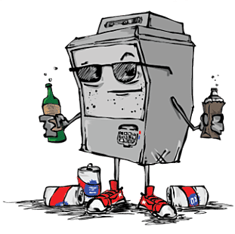Are Your Teller Cash Recyclers and Dispensers Being Wasted?
Yes, we've all heard that Teller Cash Recyclers (TCRs) are powerful tools for increasing efficiencies, securing cash, and enhancing the client experience – so it’s no surprise that banks and credit unions heavily invest in them. What most bankers don’t know is they are wasting tens of thousands of dollars on machines that aren’t being used to their full potential — essentially, wasted TCRs.
How can you eliminate this evil waste and get more out of your cash automation investment? Admitting you have a problem is the first step...and that means you must find where the waste is occurring.
Here's a surprising fact to consider: 90% of financial institutions buy cash recyclers they don't need.

The 5 Wastes of Cash Automation
The traditional routine of buying TCRs, plugging them in, then walking away and assuming they’re being used optimally is where the waste begins. Here is a look at the 5 biggest ways TCRs get wasted:
Waste #1: Misdeployed/Underutilized Machines
Misdeployed or underutilized machines are one of the biggest sources of wasted TCRs. Unfortunately, it's also one of the hardest to see — especially when you have staff giving you positive feedback on how great the machines are working.
For example, you might have two recyclers in a branch and think they are delivering great benefits – transactions are faster, the staff is happier. In reality, only one side of each machine is being used (i.e. 50% utilization rate). Meaning, you are paying for two machines when you really only need one.
Waste #2: Unused/Broken Machines
Even worse than misdeployed machines are ones that are broken or completely unused. Surprisingly, it happens a lot more than you think—on average 17% of cash automation machines purchased aren’t being used!
How can that possibly happen? When you don't know what your inventory is, or how it's being used—wasted TCRs happen. For example, if the person at corporate responsible for managing the TCR fleet has no visibility into machines that are turned on or which ones are just sitting there—it's easy to miss a wasted TCR.
Waste #3: Limited Hardware Choice
When it comes to creating an integrated TCR fleet, most financial institutions are limited to specific makes and models of hardware — which forces them to waste money on overpriced machines that are oftentimes not even the best fit.
Waste #4: Paying for Service You Don’t Need
Most financial institutions are spending thousands of dollars on services they don’t need.
With no data into how often your machines really need preventative maintenance or what a fair service contract price should be, you end up paying an inflated amount based on an industry average of the busiest and worst-performing machines — always higher than what it should be.
Waste #5 Buying Machines You Don’t Need
All of these poorly deployed, underutilized, broken, and unused machines lurking in most branch networks leads to the ultimate waste — buying extra machines you don’t need. To make the most of your investment, you must make sure that every machine you buy is necessary.
What's the solution to get the most out of your cash automation investment, reduce costs, and eliminate waste? It's visibility into how TCRs are being used and performing, then leveraging that visibility to remove the waste and optimize your fleet.
Identify the waste. Eliminate it. Run your financial institution leaner with iQ.